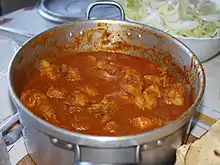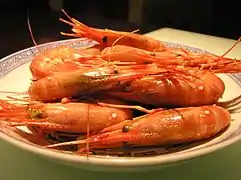Balchão
Balchão has been described as "a fiery dish from Goa (in coastal western India) which is almost like a pickle".[1] It is a spicy seafood or meat dish in Goan cuisine.
 Goan calamari balchao with parboiled rice | |
| Alternative names | Balichão |
|---|---|
| Type | Sauce or curry |
| Place of origin | India, Macao |
| Region or state | Goa |
| Main ingredients | Fish, prawns, or pork |
Ingredients
Balchão is a method of cooking, made with either fish (de peixe), prawns (de camarão), or pork (de porco), in a spicy and tangy tomato-chili sauce.[2] It resembles pickling and can be made days in advance without reheating. Some Goans make prawn balchao in tamarind sauce.
The traditional balchão uses a paste made from dried shrimp known as galmbo in Konkani.
Its ingredients could include prawns, oil, onions chopped fine, tomatoes, garlic paste or cloves, ginger paste or ginger, dried red chillies, cumin seed, mustard seeds, cinnamon, cloves, sugar, vinegar and salt.[1]
Preparation
Methods describing how to prepare it suggesting cleaning and deveining the prawns, sprinkling salt on them in a large bowl and setting the same aside. Red chillies, cumin seeds, mustard seeds, cloves and cinnamon are roasted in a dry pan till the aroma is felt. This is cooled. Ginger, garlic and roasted spices are ground into a paste with the vinegar. Oil is heated, the prawns are added and stir-fried till opaque. Next, the pan is used to fry onions. Once onions are light brown, tomatoes are added and fried till soft. Spice-vinegar paste is added, with sugar and salt. This is fried till the oil begins to separate from the masala, prawns are added, and the mix is cooked for 2-3 minutes.[1]
Balchão is usually served with hot, plain boiled rice. It can also be refrigerated, and will keep for a long time in the fridge.
History
Balchão was introduced to India by the Portuguese during colonization, most likely from Malacca (today Melaka).
Preparation

Catholic homes may use coconut vinegar for its acidic sharpness, while Hindu families may use cane vinegar to make it milder. It is now common to use white vinegar or malt vinegar.
See also
References
- "Pickle Style Dry Goan Prawns". The Spruce Eats. Retrieved 17 October 2018.
- Amelia Thomas; Amy Karafin (1 October 2009). Goa and Mumbai. Lonely Planet. pp. 60–. ISBN 978-1-74104-894-0. Retrieved 14 August 2012.
